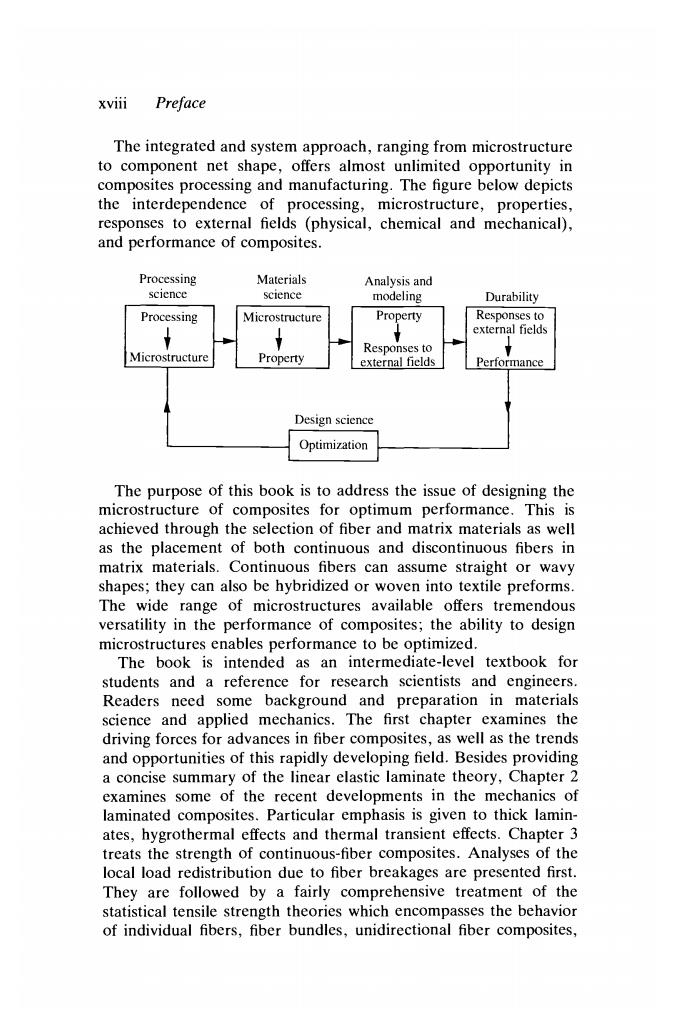正在加载图片...

xviii Preface The integrated and system approach,ranging from microstructure to component net shape,offers almost unlimited opportunity in composites processing and manufacturing.The figure below depicts the interdependence of processing,microstructure,properties, responses to external fields (physical,chemical and mechanical), and performance of composites. Processing Materials Analysis and science science modeling Durability Processing Microstructure Property Responses to external fields Microstructure Responses to Property external fields Performance Design science Optimization The purpose of this book is to address the issue of designing the microstructure of composites for optimum performance.This is achieved through the selection of fiber and matrix materials as well as the placement of both continuous and discontinuous fibers in matrix materials.Continuous fibers can assume straight or wavy shapes;they can also be hybridized or woven into textile preforms. The wide range of microstructures available offers tremendous versatility in the performance of composites;the ability to design microstructures enables performance to be optimized. The book is intended as an intermediate-level textbook for students and a reference for research scientists and engineers. Readers need some background and preparation in materials science and applied mechanics.The first chapter examines the driving forces for advances in fiber composites,as well as the trends and opportunities of this rapidly developing field.Besides providing a concise summary of the linear elastic laminate theory,Chapter 2 examines some of the recent developments in the mechanics of laminated composites.Particular emphasis is given to thick lamin- ates,hygrothermal effects and thermal transient effects.Chapter 3 treats the strength of continuous-fiber composites.Analyses of the local load redistribution due to fiber breakages are presented first. They are followed by a fairly comprehensive treatment of the statistical tensile strength theories which encompasses the behavior of individual fibers,fiber bundles,unidirectional fiber composites,xviii Preface The integrated and system approach, ranging from microstructure to component net shape, offers almost unlimited opportunity in composites processing and manufacturing. The figure below depicts the interdependence of processing, microstructure, properties, responses to external fields (physical, chemical and mechanical), and performance of composites. Processing science Proc J 1 Micros essing \ tructure Materials science Microstructure crostructu Analysis and modeling Property Responses to external fields Durability Responses to external fields Performance Design science Optimization The purpose of this book is to address the issue of designing the microstructure of composites for optimum performance. This is achieved through the selection of fiber and matrix materials as well as the placement of both continuous and discontinuous fibers in matrix materials. Continuous fibers can assume straight or wavy shapes; they can also be hybridized or woven into textile preforms. The wide range of microstructures available offers tremendous versatility in the performance of composites; the ability to design microstructures enables performance to be optimized. The book is intended as an intermediate-level textbook for students and a reference for research scientists and engineers. Readers need some background and preparation in materials science and applied mechanics. The first chapter examines the driving forces for advances in fiber composites, as well as the trends and opportunities of this rapidly developing field. Besides providing a concise summary of the linear elastic laminate theory, Chapter 2 examines some of the recent developments in the mechanics of laminated composites. Particular emphasis is given to thick laminates, hygrothermal effects and thermal transient effects. Chapter 3 treats the strength of continuous-fiber composites. Analyses of the local load redistribution due to fiber breakages are presented first. They are followed by a fairly comprehensive treatment of the statistical tensile strength theories which encompasses the behavior of individual fibers, fiber bundles, unidirectional fiber composites